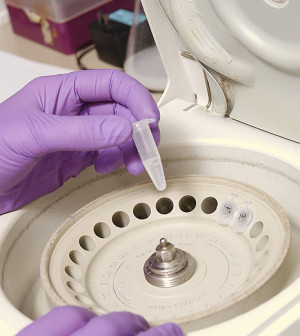- Navigating Your Midlife Crisis: Embracing New Possibilities
- City Raccoons Showing Signs of Domestication
- Mapping the Exposome: Science Broadens Focus to Environmental Disease Triggers
- One Week Less on Social Media Linked to Better Mental Health
- Your Brain Changes in Stages as You Age, Study Finds
- Some Suicide Victims Show No Typical Warning Signs, Study Finds
- ByHeart Formula Faces Lawsuits After Babies Sickened With Botulism
- Switch to Vegan Diet Could Cut Your Greenhouse Gas Emissions in Half
- Regular Bedtime Does Wonders for Blood Pressure
- Dining Alone Could Mean Worse Nutrition for Seniors
Computer-Aided Mammograms May Not Be Worth the Cost: Study


A commonly used computer-aided mammography tool may not improve breast cancer detection, a new study contends.
The finding is based on an analysis of more than 625,000 mammograms conducted between 2003 and 2009.
“Studies on [computer-aided detection, or CAD] have been inconsistent, so we set out to do a definitive study to see once and for all if CAD actually improves a radiologist’s interpretation of a mammogram or not,” said study leader Dr. Constance Lehman. She is co-director of the Avon Comprehensive Breast Evaluation Center at Massachusetts General Hospital in Boston.
After controlling for key variables, “we found that CAD does not improve performance. It offers no benefit,” Lehman said.
“What I would say to women is that when going for a mammogram, they should certainly want to go to high-quality health centers. But whether a center is using [computer-aided detection] or not is not a relevant factor in assessing quality,” said Lehman, who conducted the research while at the University of Washington in Seattle.
The findings appear in the Sept. 28 online edition of JAMA Internal Medicine.
The U.S. Food and Drug Administration approved use of costly computer-aided detection in conjunction with digital mammography in 1998, the researchers said in background notes. And in 2002 the government raised reimbursement rates by Medicare and Medicaid.
As a result, by 2008 nearly three-quarters of all facilities catering to senior women — namely those with Medicare — used computer-aided detection during mammogram evaluations.
According to the study authors, use of the computerized tool costs more than $400 million a year.
The current investigation compared results of nearly half a million mammogram screenings done using computer-aided detection with nearly 130,000 mammograms evaluated without the computerized assistance.
The screenings, which involved nearly 324,000 women ages 40 to 89, were interpreted by 271 radiologists. All the screenings took place after 2003, by which point radiologists should have been well-versed in how to use the computer software, the researchers said.
Lehman said computer-aided detection failed to improve cancer detection, or sensitivity or specificity performance relative to mammography screenings evaluated without the expensive software.
Sensitivity is a test’s ability to accurately identify those who do have the disease, and specificity is the ability to identify those who do not have the disease.
The overall cancer detection rate was 4.1 in
1,000 women screened with either method, the study found.
“There may be reasons that a center or radiologist may still want to use this,” Lehman said of the software.
“For example, some centers might feel that CAD improves workflow by speeding up the time it takes for radiologist to read charts. We did not look at that, and if that’s the case that’s fine,” she said. “But then that’s an administrative issue, not a clinical concern. And it’s not a cost that should be passed on to patients.”
In an accompanying journal editorial, Dr. Joshua Fenton backed Lehman’s conclusion that CAD “adds no benefit beyond what is achieved from standard mammography without CAD.”
But Fenton, an associate professor of family and community medicine at the University of California, Davis, added that as long as the technology continues to be covered by insurance, “providers will continue to use it and bill for it.
“That’s why Congress should step in and cease Medicare reimbursements,” said Fenton.
For now, the American College of Radiology states that “CAD, when used for screening or diagnostic film screen mammography, can be a valuable procedure to aid in the early detection of breast cancer.”
More information
There’s more on mammograms at the U.S. National Cancer Institute.
Source: HealthDay
Copyright © 2025 HealthDay. All rights reserved.










